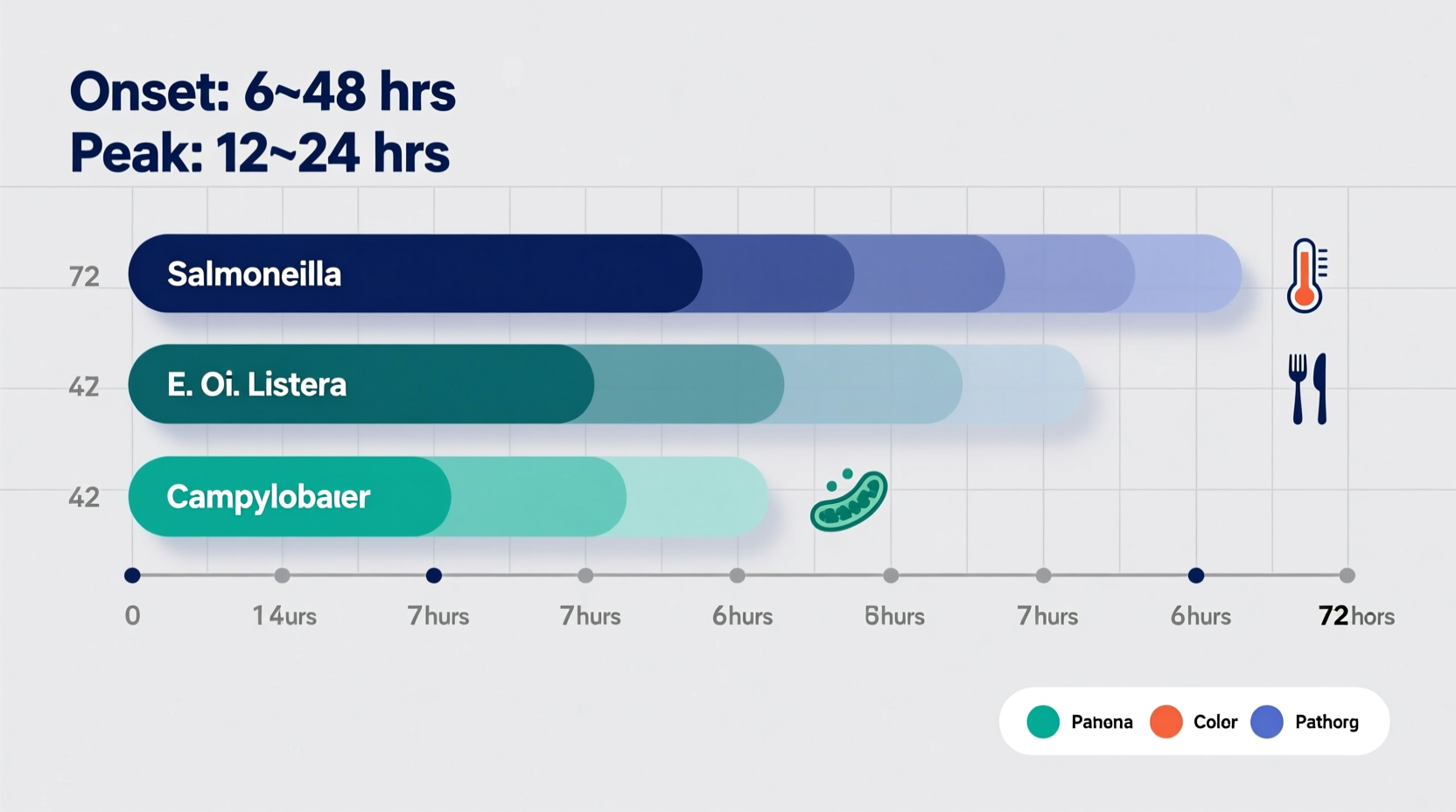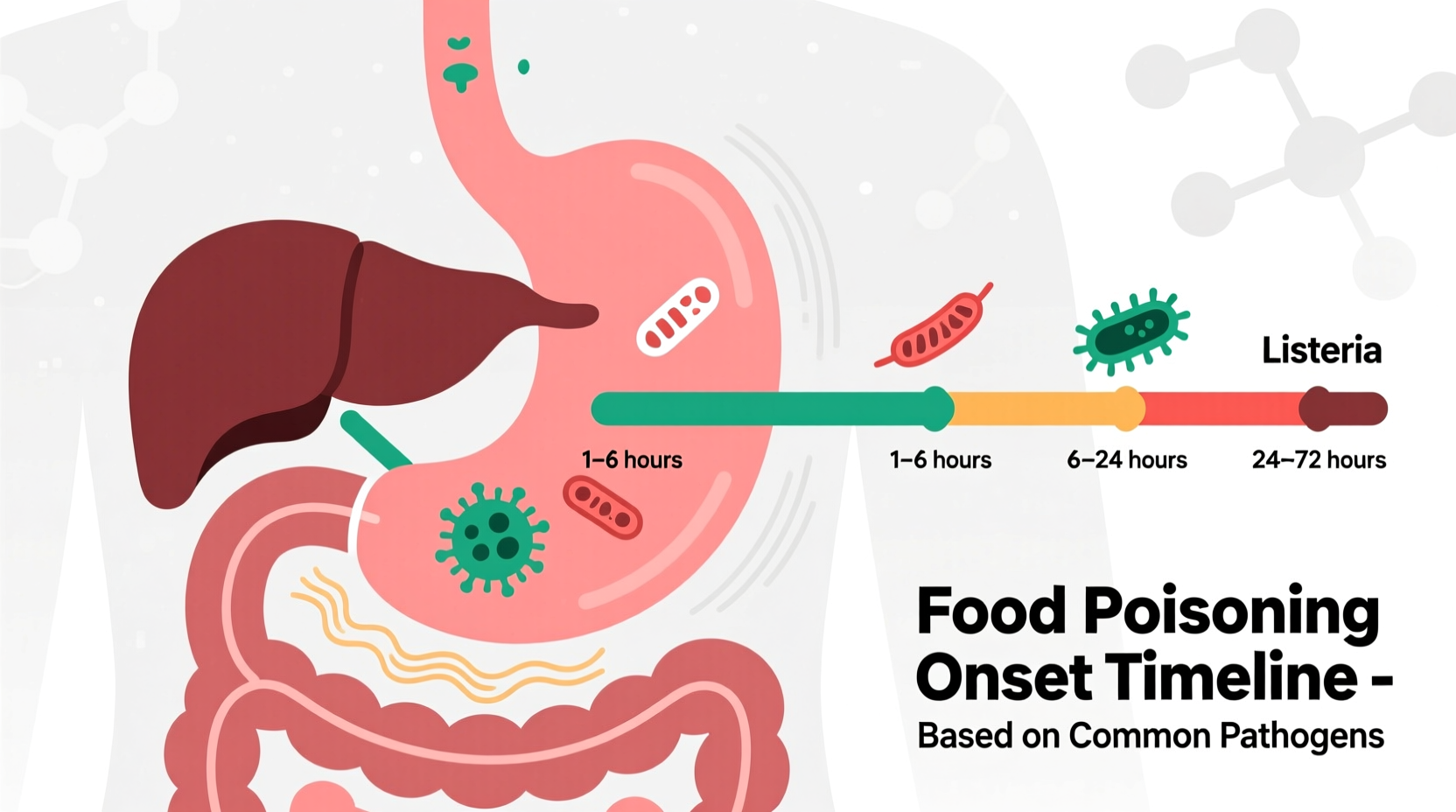Understanding Food Poisoning Onset Timelines
When you've eaten something questionable, every minute counts. Knowing how quickly food poisoning hits can help you determine whether your symptoms are related to recent food consumption or another illness. Most foodborne illnesses follow predictable patterns based on the specific pathogen involved.
Food Poisoning Timeline: How Fast Symptoms Appear
The speed at which food poisoning symptoms develop varies significantly depending on the contaminant. Here's a comprehensive timeline of common foodborne pathogens and their typical onset periods:
| Pathogen | Onset Time | Common Sources | Symptoms Duration |
|---|---|---|---|
| Staphylococcus aureus | 30 minutes - 8 hours | Ready-to-eat foods, sandwiches, salads | 1-2 days |
| Bacillus cereus (vomiting type) | 30 minutes - 6 hours | Fried rice, other cooked starches | 6-24 hours |
| Salmonella | 6 hours - 6 days | Raw eggs, poultry, meat | 4-7 days |
| E. coli | 1-10 days | Undercooked ground beef, raw milk | 5-10 days |
| Listeria | 1-4 weeks | Soft cheeses, deli meats, unpasteurized dairy | Variable |
This timeline comes from the Centers for Disease Control and Prevention (CDC), which tracks foodborne illness patterns across the United States. The CDC notes that "the onset time for foodborne illnesses can range from minutes to weeks," making it challenging to pinpoint the exact source without proper medical evaluation.
Why Onset Times Vary: Key Factors
Several critical factors determine how quickly food poisoning hits after consuming contaminated food:
Pathogen Type and Quantity
As shown in the timeline above, different bacteria, viruses, and toxins have varying incubation periods. The amount of pathogen consumed also matters—larger quantities often lead to faster symptom onset. According to the FDA's Food Code, "the dose makes the poison" applies directly to foodborne illness—higher contamination levels typically cause symptoms to appear more rapidly.
Individual Health Factors
Your immune system strength significantly impacts how quickly symptoms develop. People with compromised immune systems, young children, and older adults often experience faster onset and more severe symptoms. The World Health Organization reports that "vulnerable populations may experience symptoms sooner and with greater severity" compared to healthy adults.
Food Matrix Effects
The type of food consumed affects how quickly pathogens reach your system. Fatty foods can slow gastric emptying, potentially delaying symptom onset, while liquid foods may allow faster movement through the digestive tract. This explains why some food poisoning cases from beverages like contaminated juice can hit within 30 minutes.

Early Warning Signs to Watch For
When food poisoning hits quickly (within 1-6 hours), symptoms often begin suddenly. Be alert for these early indicators:
- Nausea that comes on abruptly
- Sudden stomach cramps or abdominal pain
- Excessive sweating or clamminess
- Dizziness or lightheadedness
- Initial vomiting episodes
These early symptoms often progress rapidly to diarrhea, fever, and dehydration. If you experience symptoms within 2 hours of eating, it's likely caused by a preformed toxin like Staphylococcus aureus or Bacillus cereus, which act faster than bacterial infections that need time to multiply in your system.
When to Seek Immediate Medical Attention
While most food poisoning cases resolve on their own, certain situations require prompt medical care. Contact a healthcare provider immediately if you experience:
- Symptoms beginning within 30-60 minutes of eating
- Blood in vomit or stool
- Signs of severe dehydration (dry mouth, little or no urination, dizziness)
- High fever (above 101.5°F or 38.6°C)
- Neurological symptoms like blurred vision or muscle weakness
- Symptoms lasting more than 3 days without improvement
The Mayo Clinic emphasizes that "food poisoning that develops within a few hours of eating contaminated food likely results from a toxin, such as that produced by Staphylococcus aureus or Bacillus cereus. These types of food poisoning often cause more immediate and severe vomiting."
Preventing Rapid-Onset Food Poisoning
Understanding how quickly food poisoning can hit underscores the importance of prevention. Follow these evidence-based food safety practices:
- Keep hot foods hot (above 140°F/60°C) and cold foods cold (below 40°F/4°C)
- Wash hands thoroughly before handling food and after touching raw meat
- Cook meats to proper internal temperatures (use a food thermometer)
- Avoid cross-contamination between raw and ready-to-eat foods
- Refrigerate leftovers within 2 hours (1 hour if temperatures exceed 90°F/32°C)
Remember that pathogens like Staphylococcus aureus produce heat-stable toxins that aren't destroyed by cooking, which is why proper food handling and temperature control are critical for preventing rapid-onset food poisoning.
Recovering from Food Poisoning
If you do experience food poisoning, focus on these recovery steps:
- Stay hydrated with small sips of clear fluids or oral rehydration solutions
- Avoid solid foods until vomiting subsides, then start with bland foods
- Rest to allow your body to fight the infection
- Don't take anti-diarrheal medications for certain types of food poisoning (like E. coli) without medical advice
- Monitor symptoms and seek medical help if they worsen or persist
Most cases of rapid-onset food poisoning resolve within 24-48 hours with proper hydration and rest. However, if symptoms began within 30-60 minutes or include neurological symptoms, seek immediate medical attention as these could indicate more serious contamination.











 浙公网安备
33010002000092号
浙公网安备
33010002000092号 浙B2-20120091-4
浙B2-20120091-4